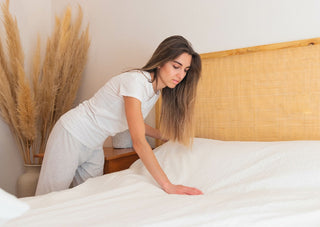Moth Larvae in Mattresses: Complete Guide for Identifying and Removing Bed Worms
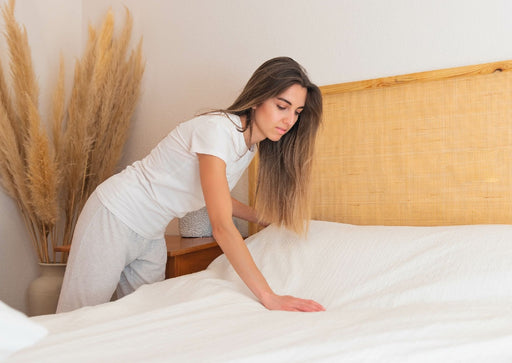
The saying “Good night, sleep tight, and don't let the bedbugs bite” really does hit differently if you’ve ever been unfortunate enough to find bed worms in your mattress. Small white, brown, or greyish worms may be the larvae of several different types of insects. This may include carpet beetles, fleas, or moths.
Textile moths such as Clothes Moths are most commonly known for laying their eggs in the fibres of a mattress or bedding made of natural materials. When these eggs hatch, the larvae that emerge resemble small worms. It’s important to identify and eliminate these bedroom pests as soon as possible to prevent further damage, preserve your health, and maintain your peace of mind.
So how do you get rid of bed worms? In this complete guide, we will cover everything to know about the larvae of the Clothes Moth, otherwise sometimes called a “mattress worm” or “bed worm”. We’ll also comprehensively answer some of your frequently asked questions on worms found in mattresses and bedding. That way, you can get the creepy crawlies out of your bedroom and focus on getting a peaceful night’s sleep!
All About Bed Worms & How to Get Rid of Them
No one wants to share their sleeping space with insects of any kind. Not only can having insects like bed worms infest your mattress cause expensive damage, but the presence of bugs in your bed can also lead to health issues like allergy flare-ups as well as an array of other unpleasant side effects. To help you take action against these invaders, let’s take a look at what bed worms are, what they do, how they get into your home, and most importantly, how to kill bed worms.
What are bed worms?
Terms such as “bed worms” or “mattress worms” can be applied to essentially any sort of insect or parasite found in bedding or within the padding of a mattress that resembles a worm or caterpillar. This may even include parasitic insects like tapeworms. However, most worms found in beds or mattresses are actually insect larvae rather than parasites. Nevertheless, if you have pets like cats or dogs that sleep with you at night, there's a chance that you are dealing with residual parasites. Here are the different kinds of bed worms and what to look for in the identification process.
The Larvae of Carpet Moths
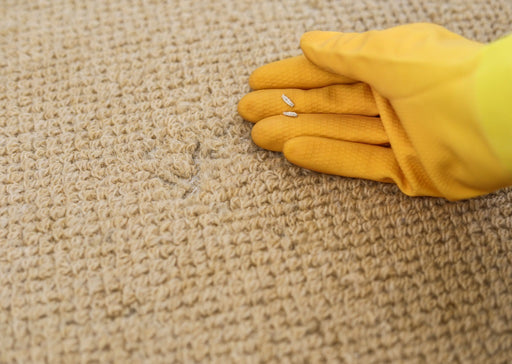
Case-bearing Carpet Moths consume animal based fibres, so everything from your woollens to your textiles are a food source for them.. The larvae of the Carpet Moth are usually a yellow or cream colour and have heads that are darker in color. These moth larvae are also opaque and in the grub phase, can weave sack-like cases around themselves before they pupate.
The Larvae of Clothes Moths
The larvae of Common Clothes Moths will usually be shiny and white or cream-coloured with head capsules that are darker. These larvae spin webbing tubes or silken cases as they feed. They can grow as large as a centimetre long. Similar to Carpet Moth Larvae they will eat their way through animal based fibres that contain the protein keratin, which include silk, wool, leather, and feathers.
The Larvae of Carpet Beetles
The larvae of the Carpet Beetle can take on many appearances, depending on the specific species. However, these larvae usually measure four or five millimetres in length and have coarse little hairs on their bodies. The small hairs distinguish them from other types of insect larvae. Often, Carpet Beetle Larvae are carrot-shaped or oval-shaped and can be brown, tan, or white.
Flea Larvae
Flea larvae also resemble very tiny worms. However, since they are so small, they can be difficult to spot. In blankets or against contrasting backdrops like sheets or mattresses, Flea larvae usually look like c-shaped little flecks. They can be a white, pale grey, or dark brown colour, depending on how long it has been since they last fed.
Identifying Bed Worms: Parasites VS Insect Larvae
It's important to be able to tell the difference between insect larvae and parasites. Moth, beetle, and flea larvae hatch from eggs, so you will have to treat the infested item at the source. However, parasitic worms most often come from household pets and must be dealt with differently.
How can you tell the difference between larvae and parasites?
First, consider whether your pets have been frequenting your bedroom spaces. Cats can get worms such as roundworms, hookworms, and tapeworms, from hunting mice outdoors. Dogs can also become infected with an array of parasitic worms. These worms or worm segments are usually yellowish or white in colour, shiny, and semi-transparent.
Parasitic worms are the same colour all of the way through, with no markings or deviations. They tend to also dry out when exposed to air. If you notice a white "noodle-like" segment of a tapeworm or something similar in your bed, you will need to wash your bedding using the sanitary cycle of your washer. You should also de-worm your pets and take action to solve any parasitic infestations in your household.
With that being said, insect larvae are by and large the most common reason for bed worms. These larvae will usually come from Clothes Moths, Carpet Moths, Carpet Beetles, or Fleas, and can live independently outside of a host without drying out. The larvae of these insects also resemble caterpillars, rather than actual worms.
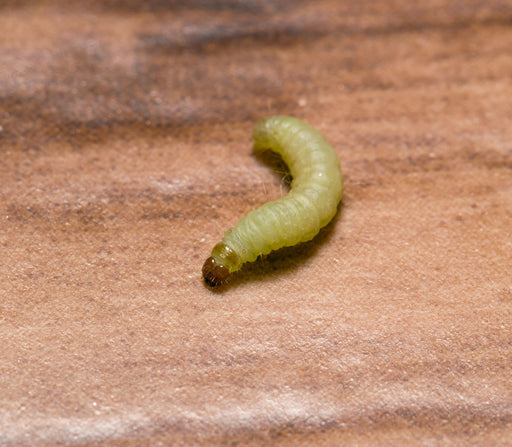
What do bed larvae and parasites look like?
Insect larvae can be brown, tan, grey, yellowish, or white in colour, and will be able to crawl, instead of just wriggling about as parasitic worms do. They will also usually have heads or body segments with different colours. For example, Carpet Moth Larvae have brownish heads with white bodies. Common Clothes Moth Larvae are often a light yellow colour with tan heads. Carpet Beetle Larvae are usually a brown or amber colour.
What do bed worms do?
The larvae of insects like Clothes Moths and Carpet Beetles hatch from eggs and then begin to chew through the nearest available food source. If your mattress has some sort of edible material on or inside of it, this could provide a food source for the larvae.
Bed worms can eventually cause significant damage to your mattress, bedding, and any clothing or textiles nearby that contain animal based fibres. Eventually, the larvae will mature into adult insects, breed, and repeat the cycle. For this reason, eliminating an infestation as soon as possible at its source is paramount.
How do bed worms start?
You may find yourself asking things like why do I have bed worms, where do bed worms come from, and what causes bed worms in the first place? While these are all fair questions, the answers can be a little more complicated. For instance, some mattresses are stuffed with natural fibres such as wool, feathers or cashmere.
While these high-end materials can give you a great night's sleep, they may also attract certain insects, like Clothes Moths, that feed on these materials. Usually, this will only happen if the mattress is exposed to the elements.
However, sometimes the larvae can come from eggs that were attached to another piece of furniture. If you bought a used rug, for example, there could have been eggs laid by an adult female moth at the thrift store.
Cluttered environments, storage units, and other scenarios can also lead to bed worms. Regularly cleaning sleeping spaces, washing bedding, and keeping mattresses stored indoors and covered by plastic during storage, can help prevent infestations from insects.
In addition to this, storing food in or near your bed could lead to an infestation of insects. Food should be stored in sealed containers and thrown away before it expires. This can help to prevent all sorts of insects and their larvae, including bed worms.
Possible causes of bed worms include:

- Mattresses that contain natural fibres (wool, alpaca, cashmere, etc.)
- Second-hand items with moth eggs hidden in or on them
- Storing food improperly in the bedroom
- Excessively dirty or cluttered environments
- Taking bedding camping with you and forgetting to wash it before putting it back on the bed
- Keeping a mattress in a storage unit or leaving it outdoors for any extended period without protection
- Having real fur or leather blankets, throw pillows, or decor items near the bed and not regularly cleaning or inspecting them
How To Get Rid of Bed Worms for Good
Now that you have a better understanding of what these worms may be and how an infestation could have started, how do you get bed worms out of a mattress? Let’s go through how to kill bed worms step-by-step so that you can get your sleeping quarters clean and pest-free.
Step 1: Strip Bedding and Stand Your Mattress Up
First of all, you will need to strip the bedding off of your bed and wash it on the hottest cycle in your washing machine. Then, stand your mattress up so that you can see what's going on under and around your bed. Identify any areas that need to be cleaned or vacuumed. If you have a box spring, check it for signs of insect activity as well.
Step 2: Vacuum Thoroughly
Vacuum your mattress and box spring thoroughly. You will also need to vacuum around the bed frame, headboard, mouldings, under the feet of your bed, and in all cracks and crevices. Vacuuming will thoroughly remove most larva and adult insects. Be sure to empty your vacuum canister or bag immediately and far away from your home to prevent spreading the infestation.
Step 3: Treat with Insect Killer
Now, treat your mattress with an insect-killing spray. There are many options available that can be used on mattresses and fabrics and are fairly safe around people. Bed Bug sprays can work to kill Carpet Beetles as well. While it is not safe to consume these sprays, they are often fine to use on furniture and textiles. Just be sure to read the directions carefully.
MothPrevention Clothes Moth Killer Kits and Carpet Moth Killer Kits contain fumers and residual sprays that will eliminate Moths, Larvae and Eggs.
Another option is diatomaceous earth. You can use diatomaceous earth (which resembles baking soda or powders) to sprinkle-coat your mattress. Let it sit for a few minutes, and then vacuum it out. This powder is safe around people, kids, and pets. In many cases, you can even get diatomaceous earth in food-grade form. Diatomaceous earth suffocates insects of all sizes that come in contact with it, as it causes suffocation through the exoskeleton.
Step 4: Clean the Entire Room

It's also a smart move to clean your entire bedroom if you've noticed an infestation of insects in your bed or mattress. Wash all fabrics, shampoo the carpets, and wipe down surfaces as well. As you clean, look for possible infestation sources or any larvae that you may have missed. That way, you can be sure your room is bug-free and sleep soundly at night.
Step 5: Implement a Good Defence to Prevent Re-infestation
Now, it's time to prevent these disgusting little bugs from ever coming back. One option is to get a mattress encasement. These mattress covers zip around your mattress and will help protect you from any eggs hatching or insects emerging from the seams if you missed anything while cleaning. Moreover, they will keep bugs out of your mattress as well.
Then, seal up any cracks or crevices in your room where insects may be getting inside. It is also smart to place Clothes Moth Traps and Carpet Moth Traps to catch the active adult male moths and help break the breeding cycle. Moth Traps are a natural and highly effective option that use powerful female pheromones on their sticky strips to attract the male moths.
FAQs on the Mattress Worm or Bed Worm Infestations
Below, we will answer some of the most frequently asked questions regarding bed worms, mattress worms, and other creepy crawlies that may be plaguing your bedroom.
What do bed worms turn into?
Bed worms are often the larvae of beetles or moths. As such, they will turn into adult beetles or moths. Common moth and beetle species that consume fabrics include Clothes Moths, Carpet Beetles, and Carpet Moths.
Why are there tiny worms in my bed?
Tiny worms in mattresses or bedding may be the larvae of beetles or moths. It is also possible that parasites like tapeworms or pin worms have fallen out of a host (like a cat or dog) and onto your bedding.
What are these little worms in my bed?
If you are seeing little worms in your bed, you could be dealing with Carpet Beetle Larvae, Clothes Moth Larvae, Carpet Moth Larvae, or another type of insect that consumes animal based fibers in the larval stage. If you have food stored in the bedroom, you may also be seeing the larva of the Pantry Moth or Pantry Beetle.
Do bed bugs look like worms?
No, bed bugs don't resemble worms or go through a larval stage. Bed bugs are small red or brown insects that feed on blood. They do have a nymph stage, in which they look very much like adult bed bugs, just smaller and flatter.
What do bed worms look like?
Bed worms can take many shapes and forms. Usually, bed worms are small brown, yellow, white, grey, or tan, larvae from beetles or moths. The larvae will be segmented and may have heads that are darker in colour than the rest of their bodies. Usually, these larvae resemble tiny caterpillars.
Why do bed worms appear?
An infestation of bed worms may occur for various reasons. For instance, if an adult Clothes Moth lays eggs on or near a mattress that has been exposed to the elements, these eggs will hatch into small larvae that can resemble worms. Carpet Beetle Larvae can also hatch from eggs. Oftentimes, adult egg-laying insects attach eggs to a mattress’s fibres while the mattress is exposed to the elements such as when kept in a storage unit or left outside overnight. However, these insects can also invade homes or be accidentally brought inside from thrift store furniture.
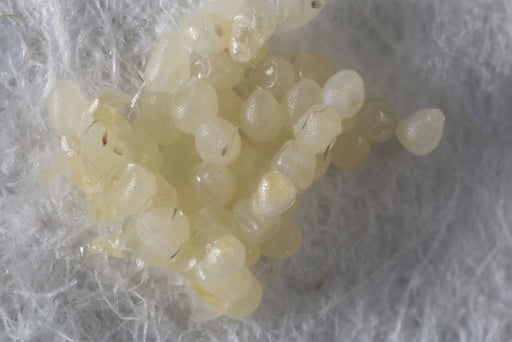
How do I know if my mattress has worms?
Mattress worms are visible to the naked eye because they are usually the larvae of Carpet Beetles, Clothes Moths, or Carpet Moths. flea larvae are small and C-shaped and can be hard to see. If a mattress is very old, excessively dirty, or has been stored outside, you should check for insect infestations and bed bugs before bringing it into your home. To do this, grab a flashlight and carefully check all of the crevices, creases, and folds of a mattress for signs of insects and bedbugs. Look for discoloration and reddish or brownish spots, as these could indicate bed bug excrement.
What are the tiny worms that curl up?
Tiny worms that curl up into a C-shape may be the larvae of fleas. However, moth larvae can also curl into a C or U-shape when disturbed. To tell the difference, just look at how large the larvae are. Moth larvae can grow to as large as one centimetre long and are usually light-coloured with darker-coloured heads. Flea larvae are far smaller, less than 2 mm in length.
What is bed worms?
If you Google terms like “What is bed worms?” or “Why does my bed look like there is worms in it?”, you will likely find that these worms are, in fact, the larvae of moths or beetles. They can also be flea larvae, or, if you have pets, deposed parasites. If there are worm-like larvae in your bed, you will need to clean all infested areas thoroughly and treat your mattress with the appropriate insecticides or sprays. Using a hypoallergenic waterproof mattress cover in the future may also help.
I found a white worm in my bed, what is it?
You may be dealing with either insect larvae or a single parasitic worm. Insect larvae will usually be found in groups of more than one. You may notice one or two Clothes Moth or Carpet Beetle caterpillars in your bedding, for instance. These larvae may be coming from a larger “nest” inside of your mattress or somewhere nearby. However, with parasitic worms that come from things like having pets in your bed, you will usually only notice a single worm on a single occasion. Most often, this will be while your pet is still in bed with you, as these worms die and shrivel up once expelled from a host.

About MothPrevention
MothPrevention® speak to customers every day about their clothes moth issues - clothes moths are a species that are ever increasing and that can cause significant damage to clothes, carpets and other home textiles.
To date, we’ve helped over 250,000 customers deal with their moth problems. We have developed professional grade solutions including proprietary pheromones and trap design engineered to the highest production standards.




